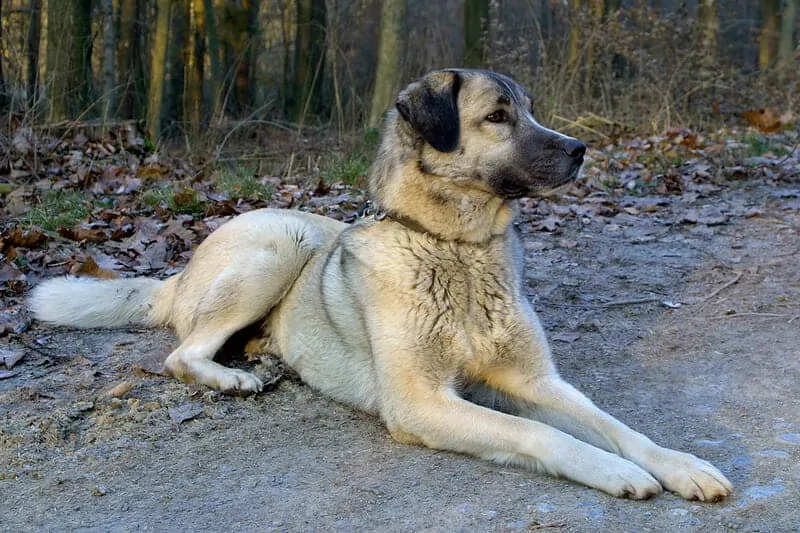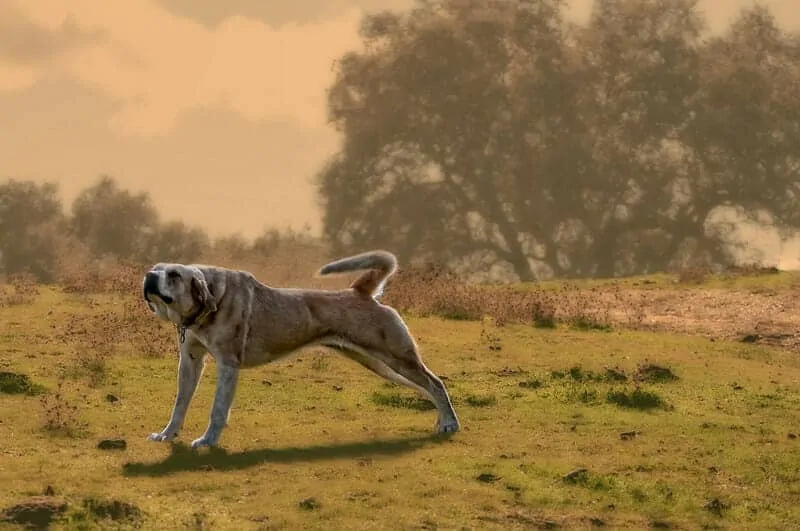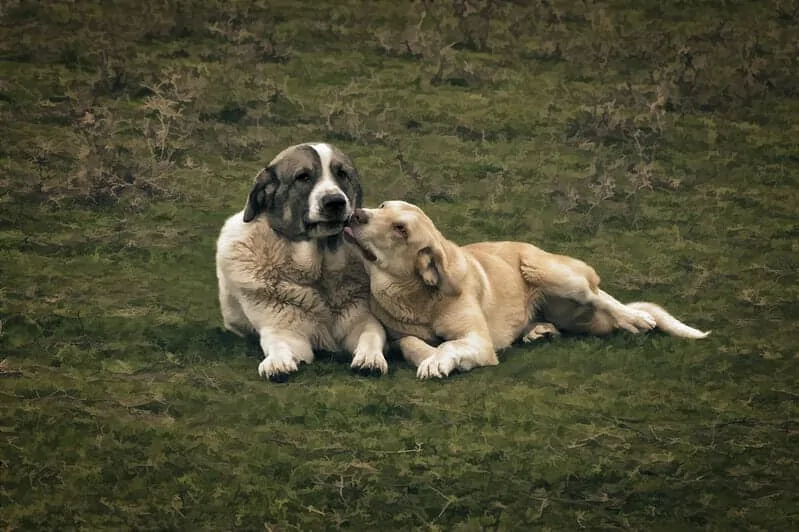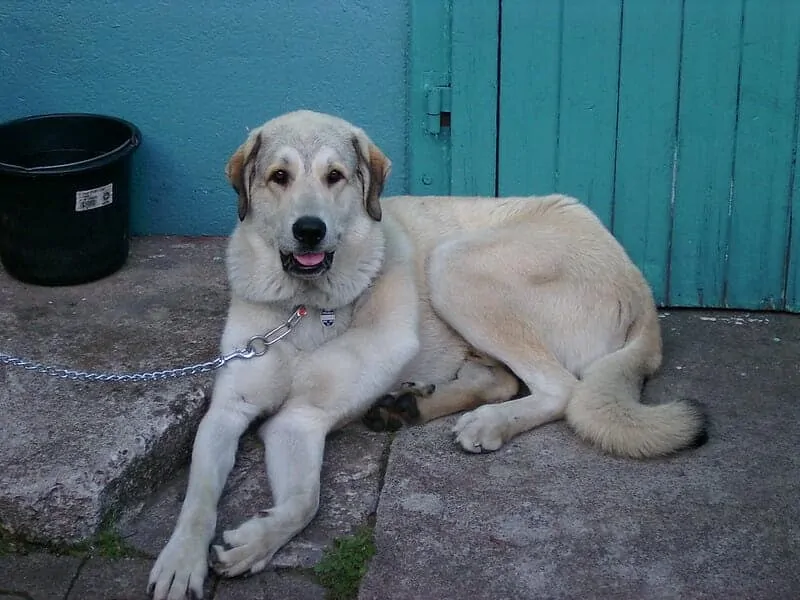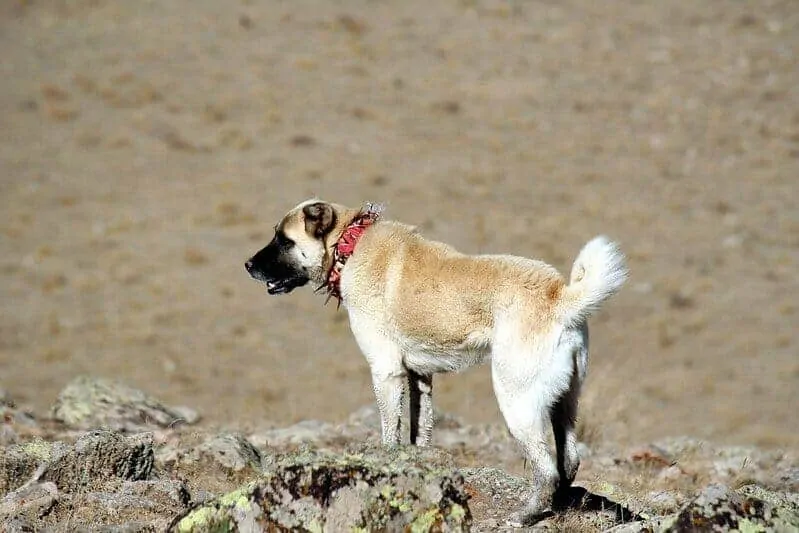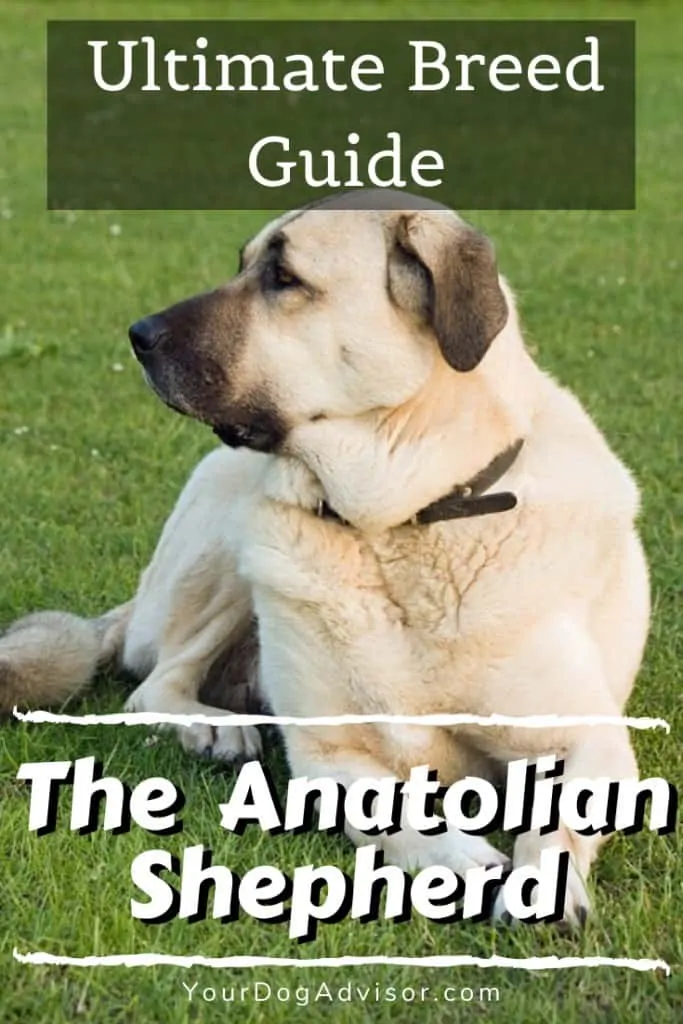Loyal, intelligent, and powerful, this ancient breed has been protecting humans and their livestock for millennia. But do Anatolian shepherds make good housepets?
In this article, we will take a deep dive into what makes this livestock guardian tick, how easy they are to care for, and whether or not they would make the right companion for your lifestyle.
Contents
General Characteristics of the Anatolian Shepherd
- Other names: Karabash, Kangal shepherd dog
- Height: 27 to 29 inches
- Weight: 80 to 150 pounds
- Lifespan: 11 to 13 years
- Origin: Turkey (Anatolia region)
- Colors: All colors are allowed, but cream, tan, and piebald, usually with a black mask, are the most common.
- Activity level: Moderate
- Grooming needs: Moderate
- Best suited for: Experienced owners with a lot of space
The AS is one of the oldest dog breeds, dating back to the bronze age. Their instinct to guard and their loyalty to their people is deeply rooted in their genes. “16242” by Chris vT / CC BY 2.0
The History of the Anatolian Shepherd
The history of the Anatolian goes back at least 6,000 years to the Anatolian peninsula. At that time, the area was inhabited by nomadic and semi-nomadic tribesmen who traveled great distances with large herds of sheep and goats. To protect their livestock from bears, wolves, and other predators, they relied on large, athletic herd guardians.
The Coban Kopegi is the oldest known breed used in the area and most likely the dog that gave rise to the Anatolian we know today. Artifacts found in this region from thousands of years ago show carvings of these large shepherd dogs. There are even mentions of what is most likely the Anatolian in the earliest stories in the bible.
The breed had to be well adapted to living in a harsh climate, one that was incredibly hot and dry in the summer and brutally cold in the winters. They also had to have the intelligence and drive to live independently of their people, often wandering for days with the herd without any direction from their owners.
Despite being one of the oldest breeds on record, they have only recently begun spreading out of their native lands.
In the 1940s, the American Department of Agriculture imported a breeding pair of Anatolians as part of a secret “sheepdog project.” The aim of the project was to find capable working dogs who could defend the growing population of US sheep against predators. Unfortunately, not long after the project began, WWII broke out and the initiative was abandoned.
These shepherds have been used for thousands of years to help herdsmen keep their flock safe from predators. Their intelligence, size, and athleticism make them a worthy adversary for wolves, bears, and even large cats. “Anatolian Shepherd, Tiltshifted” by Moonstar909 / CC BY-SA 2.0
However, it didn’t take long after the end of the war for the AS to again begin appearing in America again. In 1973 the Endangered Species Act was passed, forcing ranchers to find new, nonlethal ways to deal with wolf predation. In the growing number of Anatolians, they found their solution and the popularity of the dogs as sheep guardians took off.
Today, these dogs still remain a popular working breed around the world, though their numbers as pets are far fewer. Their ability to ward off even the most capable predators has made them the number one dog of choice utilized by the Cheetah Conservation Fund in Nambia. The non-profit group breeds Anatolians and distributes them to local villages. The dogs protect the goat herds, reducing the deadly interactions between cheetahs and villagers.
Their ability to work in harsh climates also makes the AS a popular choice for guarding sheep in the arid Australian outback. But more and more often, people are buying Anatolians not to work, but as pets. While these dogs are not for everyone, they can make great companions for the right owner.
The Temperament of the Anatolian Shepherd
Like all livestock guardians, the Anatolian shepherd is undyingly loyal and gentle with their family, protective of their people and property, and aloof with strangers.
These dogs are incredibly independent and even less accustomed to a domestic life than dogs like the great Pyrenees. This independence shows in ways that can be frustrating to the novice owner. While they learn quickly, they often refuse to follow commands or do so only on their own time. If given the freedom to roam, they will do it, often disappearing for days before showing back up.
These big dogs need a lot of room to roam. If you don’t have a large yard, expect to have to walk or hike with your shepherd daily. “Having a Stretch” by Steve Slater / CC BY 2.0
But in the right setting, the AS can make a great family dog. They enjoy affection from those they know well and are happy to lounge around the house assuming they have the freedom to work off some energy in the backyard as needed.
Many owners also prize these dogs for their natural guarding instinct. If something is off, they will let you know about it. They are frequent barkers, especially at night. Their large size and deep bark are usually enough to ward off trespassers, but they aren’t afraid to get physical if they have to. While they generally don’t go looking for fights, they are happy to finish one that comes to them.
Because of this potential aggression toward strangers and their unreliable obedience, these dogs should never be formally trained as guard or attack dogs. If aroused or angered, they are likely to take things too far, even if their owner gives them a clear indication it is time to stop.
To prevent this strong protective drive from becoming too powerful, it is important that you socialize your Anatolian shepherd puppy very well, very early. By taking them on errands, allowing them to meet different people and see different places, you can help avoid dealing with an over-reactive 150-pound adult dog.
Overall, these dogs are great with family, warry of anyone they don’t know, and as calm as they are confident. They will thrive in a home with a large, well-fenced yard and patient owners.
Learn more about this majestic dog by watching the above video.
Health Issues Common to the Anatolian Shepherd Breed
Like so many other ancient breeds, the AS has few health problems and is one of the longest-lived dogs of their size. Still, some hereditary problems exist in some lines, so it is good to be aware of those potentialities.
>>>These are a few of the longest living dog breeds.
Here are some of the more common health issues that affect this breed.
- Cancer
- Heart problems
- Entropion
- Hypothyroidism
One unique characteristic of this breed is that they do not appear to tolerate anesthesia well. Working dogs and those who wear large-breed flea collars seem especially sensitive. Typically one-tenth the normal amount of anesthesia is all that is needed to put dogs of this breed under.
As with all large dogs, it is important to feed your Anatolian shepherd puppy only large breed puppy food to help regulate their growth. While hip and elbow dysplasia are far less common in this breed than other giants, it can still occur, especially if a puppy is fed a food too high in calories.
Once a dog has reached their mature weight, usually by about 14 months old, they can be switched to any high-quality adult food. Working dogs will do best on a more calorie-dense diet given that they typically don’t overeat. Companion animals, on the other hand, may do better on a lower-calorie large breed food, depending on the amount of exercise they receive.
Unlike so many other large breed dogs, like this golden retriever, the AS enjoys a relatively long lifespan and few health concerns. Choosing a reputable breeder and feeding a quality diet will increase the odds that your AS will enjoy both of these traits. “My Recent Home Office” by Cathy Stanley-Erickson / CC BY-ND 2.0
As with all breeds, it is important to do your homework when selecting a breeder. These dogs are not overly popular, so finding a breeder in your area may not be possible. Given their unique temperaments and needs, however, there are always a few AS adolescents or adults looking for their forever home. Consider reaching out to your nearest AS rescue before contacting breeders.
Do Anatolian Shepherds Do Well With Children and Other Pets?
These giants are known for their loyalty and gentleness when it comes to their interactions with family. They typically do very well with children, especially if they were exposed to kids and babies at an early age.
Because of their size and instinct to protect, they tend to be very tolerant, even of rowdy toddler behavior. They are also incredible athletes and can make great companions for older children who like to run around outdoors.
Of course, as you would with all dogs, supervision of dogs and children is required at all times. It is especially important to introduce your AS to family visitors and friends in a way that will help your dog understand that they are not intruders.
This drive to nurture and care for the family typically extends to other pets as well. Anatolian shepherds can often be seen cuddling up to the cat or protecting other pets from other dogs in the house. To increase the odds that your dog will get along with pets of different species, early socialization with these animals is important.
How well your shepherd gets along with other dogs depends on their personality, the other dog’s personality, and how well they were socialized as a puppy. “Puppy Love Anatolian Shepherd” by Steve Slater / CC BY 2.0
Such a peaceful existence with other canine family members may be harder to achieve. These dogs often fight with dogs of the same sex. Some Anatolians with calmer dispositions may be fine sharing their house with other dogs, but just as many are too reactive. Even the slightest act of aggression by another dog, whether long-time friend or stranger, is likely to set them off.
Overall, early socialization can help your pup grow into a dog that tolerates kids, cats, and other dogs. But don’t expect all Anatolians to do well with their furry family members.
What to Consider Before Bringing Home an Anatolian Shepherd
Think you have the know-how and patience to bring one of these majestic animals into your life? Here are a few more things to consider.
Activity Level
The average adult AS will do well with a long daily walk and plenty of time spent patrolling the yard. Younger dogs will need more exercise and attention. Because of their tendency to wander and their stubborn side, these dogs should never be allowed off-leash unless in a well-enclosed area.
Since many don’t do well with unfamiliar dogs, normal activities like the dog park or dog daycare may be off-limits. Long hikes, cross country skiing, and other outdoor activities are a great choice, though.
Keeping your AS contained can prove more difficult than you might think. These dogs were born to roam and don’t always respond to a recall command. A six-foot fence is a must, with a chain being the less desirable plan B. “Anatolischer Hirtenhund” by Offenburg / CC BY-SA 2.0
Trainability
All livestock guardians have an independent streak, but these dogs, in particular, really have a mind of their own. They were bred for millennia for the sole purpose of living among the herd and running their own daily routine. They are far less domesticated than other breeds and will always choose to do what suits them rather than what suits you.
Still, with the right incentive and some patience, they can be fast learners, even if they don’t always choose to show off what they know. Your best bet is to establish boundaries and a healthy routine early on and stay consistent.
>>>Struggling to train your stubborn dog, make sure you aren’t making these common training mistakes.
Grooming
The Anatolian’s coat is shorter than the Pyrenees’ and easier to care for, but it still sheds frequently. In their home country, these dogs experience a drastic temperature shift between summer and winter and their coats react with two heavy sheds twice each year. Be prepared to brush these dogs weekly and even more often when the seasons change.
Their topcoat is coarse and tends to repel dirt and water. The occasional bath may be necessary, but overall, their bathing needs aren’t as high as other breeds. Like all breeds, they do require frequent nail trims.
Nutrition
Beyond feeding large breed specific puppy food while your AS is growing, these dogs don’t have any specific nutritional needs. They should thrive on any high-quality diet. They tend to self regulate and aren’t prone to obesity.
Working shepherds in Turkey and around the world are often adorned with large spiked collars to protect their neck during altercations with predators that are often much larger than themselves. “Anatolian Sheepdog” by yepyep / CC BY-NC-ND 2.0
Cost
The average purebred AS puppy will cost about $1,500 with some working lines going for as much as $5,000.
Overall, these dogs are healthy and won’t cost a fortune to maintain. They do require more food due to their size, so it is wise to consider that when planning a budget.
10 Fun Facts About the Anatolian Shepherd
Now that you know what it takes to care for an AS, here are a few fun facts about the breed.
- Up until recently, the Anatolian and the Kangal shepherd were considered separate breeds. But now many kennel clubs have combined these two groups into one breed.
- AS genes have been found in the Alaskan husky.
- When used to guard flocks, these dogs are known for setting off alone to find and chase predators even when they don’t pose an immediate threat to livestock.
- These dogs are incredibly fast and agile.
- When out on the land, these dogs often hunt small animals to feed themselves.
- Their lineage includes shepherd, sighthound, and mastiff bloodlines.
While they are typically used to fight off Cheetah attacks on sheep flocks in Africa, some shepherds have been recruited by zoos to keep cheetahs company by forming lifelong bonds with the kittens as puppies. “Cincinnati Zoo” by JasonBechtel / CC BY-NC-ND 2.0
- Anatolians are used in Yellowstone to reduce conflicts between wolves and bears and visitors to the park.
- These dogs are massive. Some individuals have grown tall enough to be in the running for the tallest dog alive.
- Many zoos utilize these big dogs to befriend cheetah cubs and keep the sensitive cats company throughout their lives.
- They bark a lot but are especially fond of barking at night when predators are particularly active.
Before You Go
Not sure the AS is right for you? Here are some similar breeds that might be worth considering.

Sara Seitz has spent most of her life in the pet industry and has a bachelors in animal behavior from Colorado State University. Sara started working with dogs and cats as a high schooler at a rural boarding kennel. There she learned a lot about the bad and the ugly of the pet service industry. But not even the toughest day at that job would dissuade Sara from following her dream of working with animals.
In college, Sara got a job at a dog daycare and boarding facility in Fort Collins, Colorado. Her new career provided even more opportunities for learning about dog behavior than her classes did. As general manager of the daycare, Sara helped the company launch a new in-home pet sitting branch and trained to become a certified dog trainer. Between shifts taking care of peoples pets in-home and supervising dogs during playtime at the daycare, Sara organized and taught obedience classes.
Sara has always been passionate about bettering the lives of our canine companions. She soon found that advocating for and educating owners in the power of positive reinforcement training was one of the best ways to help dogs and their owners live happier lives.
